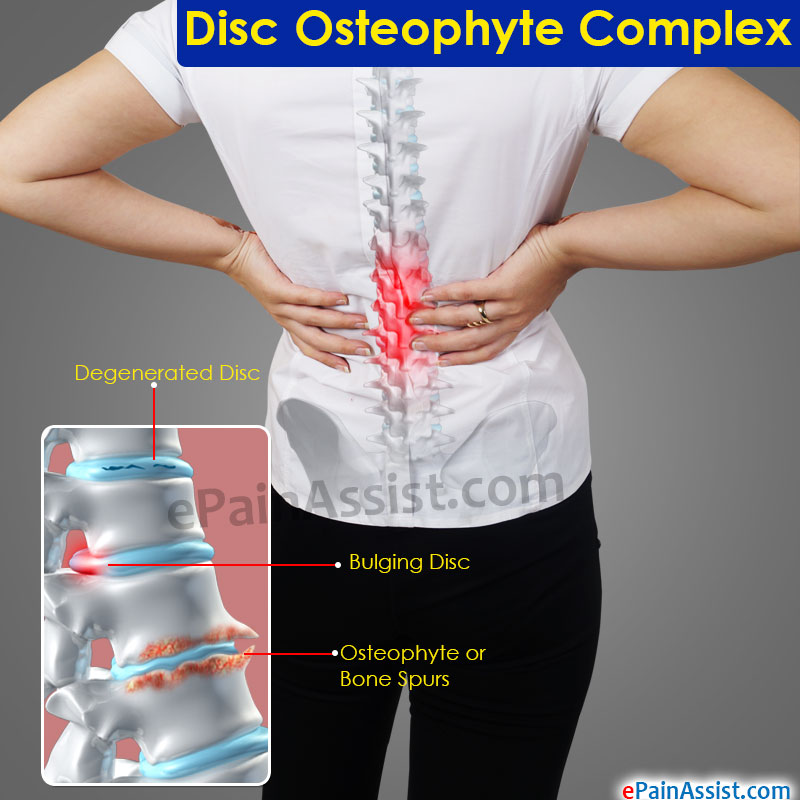What Is Disc Osteophyte Complex?
The term Disc Osteophyte Complex is given to a pathological condition where multiple spinal vertebrae intervertebral discs get affected by formation of Bone Spurs or Osteophytes.(1) Bone Spurs or Osteophytes develop due to normal wear and tear of the body normally due to aging because of which the spine tends to get weak resulting in the body producing extra bone to keep the structural integrity of the spine intact and also limit the mobility of the spine. Bone Spurs or Osteophytes also develops due to a medical condition called osteoarthritis. Most common symptom of Bone Spurs or Osteophytes is pain in the affected region but usually they are not painful unless these projections contact the nerve roots causing painful and discomforting symptoms.
How Are Disc Osteophyte Complex Caused?
Disc Osteophyte Complex normally occurs as a result of aging of an individual, although a younger individual can also get Disc Osteophyte Complex as a result of trauma or other underlying medical condition. Symptoms are produced when these osteophytes start to impinge on a nerve root. Disc Osteophyte Complex is most often found in people above the age of 60 as that is when the spine becomes weak and bony projections tend to form due to degeneration of the disc. Additionally, having osteoarthritis or having a family history of the same may also put an individual at increased risk for developing Disc Osteophyte Complex.
What Are The Symptoms Of Disc Osteophyte Complex?
Disc Osteophyte Complex itself does not cause any symptoms initially, but as osteophytes tend to grow and start rubbing on the vertebrae or impinge on a nerve root that is when an individual starts to experience pain and decreased range of motion of the affected spine. There can also be radiation of pain to the extremities. Headaches that seem to be centered in the back of the head are common. In some instances, although rare, Disc Osteophyte Complex has also caused paralysis.
How Is Disc Osteophyte Complex Diagnosed?
To diagnose Disc Osteophyte Complex, the treating physician will first take a detailed history in which the physician may ask questions related to any known history of osteoarthritis or a family history of the same. After taking a detailed history, the physician will then conduct a detailed examination of the spine to look for areas of swelling and tenderness to palpation in the spine. Once Disc Osteophyte Complex is suspected, the treating physician will order radiological studies like x-ray or MRI scan of the spine to look at the internal structures and these studies usually confirm the presence of Disc Osteophyte Complex.(2)
What Are The Treatments For Disc Osteophyte Complex?
Degenerative conditions causing Disc Osteophyte Complex if identified early enough can be treated with conservative approaches using medications like NSAIDs to calm down pain and inflammation.(2) Low impact exercises also help in relieving symptoms of pain and increase flexibility of the spine. Application of ice for 20-30 minutes two to three times a day on the affected region is also helpful for symptom control. Physical therapy is also very helpful in increasing strength of the spine. If these measures do not improve the symptoms, then corticosteroid injections are also an option for calming down symptoms. If all the above measures fail to relieve symptoms, then surgical procedure to trim down the osteophytes is done along with spinal fusion and spinal decompression for relief of symptoms of Disc Osteophyte Complex.
Also Read:
- Lumbar Disc Herniation: Causes, Symptoms, Treatment-Manual Therapy, PT, Surgery
- Types of Degenerative Disc Disease & Its Symptoms, Treatment, Pathophysiology
- Paracentral Disc Extrusion: Causes, Symptoms, Treatment
- Percutaneous Laser Disc Decompression: Who Should Consider it, Recovery Period, Benefits
Also Watch:

